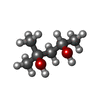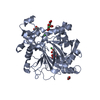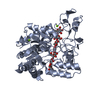+ Open data
Open data
- Basic information
Basic information
| Entry | Database: PDB / ID: 6grw | |||||||||
|---|---|---|---|---|---|---|---|---|---|---|
| Title | Glucuronoyl Esterase from Opitutus terrae (Au derivative) | |||||||||
 Components Components | Putative acetyl xylan esterase | |||||||||
 Keywords Keywords |  HYDROLASE / Carbohydrate Esterase HYDROLASE / Carbohydrate Esterase | |||||||||
| Function / homology |  Alpha/Beta hydrolase fold / Alpha/Beta hydrolase fold /  : / Putative acetyl xylan esterase : / Putative acetyl xylan esterase Function and homology information Function and homology information | |||||||||
| Biological species |   Opitutus terrae PB90-1 (bacteria) Opitutus terrae PB90-1 (bacteria) | |||||||||
| Method |  X-RAY DIFFRACTION / X-RAY DIFFRACTION /  SYNCHROTRON / SYNCHROTRON /  MOLECULAR REPLACEMENT / Resolution: 1.5 Å MOLECULAR REPLACEMENT / Resolution: 1.5 Å | |||||||||
 Authors Authors | Lo Leggio, L. / Larsbrink, J. / Meland Knudsen, R. / Mazurkewich, S. / Navarro Poulsen, J.C. | |||||||||
| Funding support |  Denmark, 2items Denmark, 2items
| |||||||||
 Citation Citation |  Journal: Biotechnol Biofuels / Year: 2018 Journal: Biotechnol Biofuels / Year: 2018Title: Biochemical and structural features of diverse bacterial glucuronoyl esterases facilitating recalcitrant biomass conversion. Authors: Arnling Baath, J. / Mazurkewich, S. / Knudsen, R.M. / Poulsen, J.N. / Olsson, L. / Lo Leggio, L. / Larsbrink, J. | |||||||||
| History |
|
- Structure visualization
Structure visualization
| Structure viewer | Molecule:  Molmil Molmil Jmol/JSmol Jmol/JSmol |
|---|
- Downloads & links
Downloads & links
- Download
Download
| PDBx/mmCIF format |  6grw.cif.gz 6grw.cif.gz | 209.4 KB | Display |  PDBx/mmCIF format PDBx/mmCIF format |
|---|---|---|---|---|
| PDB format |  pdb6grw.ent.gz pdb6grw.ent.gz | 134.5 KB | Display |  PDB format PDB format |
| PDBx/mmJSON format |  6grw.json.gz 6grw.json.gz | Tree view |  PDBx/mmJSON format PDBx/mmJSON format | |
| Others |  Other downloads Other downloads |
-Validation report
| Arichive directory |  https://data.pdbj.org/pub/pdb/validation_reports/gr/6grw https://data.pdbj.org/pub/pdb/validation_reports/gr/6grw ftp://data.pdbj.org/pub/pdb/validation_reports/gr/6grw ftp://data.pdbj.org/pub/pdb/validation_reports/gr/6grw | HTTPS FTP |
|---|
-Related structure data
- Links
Links
- Assembly
Assembly
| Deposited unit | 
| ||||||||||||
|---|---|---|---|---|---|---|---|---|---|---|---|---|---|
| 1 |
| ||||||||||||
| Unit cell |
|
- Components
Components
-Protein , 1 types, 1 molecules A
| #1: Protein | Mass: 43988.258 Da / Num. of mol.: 1 Source method: isolated from a genetically manipulated source Source: (gene. exp.)   Opitutus terrae PB90-1 (bacteria) / Gene: Oter_0116 / Production host: Opitutus terrae PB90-1 (bacteria) / Gene: Oter_0116 / Production host:   Escherichia coli BL21(DE3) (bacteria) / References: UniProt: B1ZMF4 Escherichia coli BL21(DE3) (bacteria) / References: UniProt: B1ZMF4 |
|---|
-Non-polymers , 6 types, 413 molecules 










| #2: Chemical | | #3: Chemical | ChemComp-CA / | #4: Chemical | #5: Chemical | ChemComp-MPD / ( |  2-Methyl-2,4-pentanediol 2-Methyl-2,4-pentanediol#6: Chemical | ChemComp-EDO /  Ethylene glycol Ethylene glycol#7: Water | ChemComp-HOH / |  Water Water |
|---|
-Experimental details
-Experiment
| Experiment | Method:  X-RAY DIFFRACTION / Number of used crystals: 1 X-RAY DIFFRACTION / Number of used crystals: 1 |
|---|
- Sample preparation
Sample preparation
| Crystal | Density Matthews: 1.96 Å3/Da / Density % sol: 37.16 % |
|---|---|
Crystal grow | Temperature: 293.15 K / Method: vapor diffusion, sitting drop / pH: 8 Details: Reservoir composition for crystal growth: 0.03M Magnesium chloride, 0.03 M calcium chloride, 0.05M imidazole, 0.05M MES, 10% v/v MPD, 10% w/v PEG 1000, 10% v/w PEG 3500P. Heavy atom ...Details: Reservoir composition for crystal growth: 0.03M Magnesium chloride, 0.03 M calcium chloride, 0.05M imidazole, 0.05M MES, 10% v/v MPD, 10% w/v PEG 1000, 10% v/w PEG 3500P. Heavy atom derivatization: 1.2uL crystallization mother liquor containing 0.5mM KAu(CN)2 added to drop containing crystals. Drop size and composition: Sitting drops of 0.4ul were mixed in a protein:reservoir volume ratio of 1:1 using 45 mg/mL of OtCE15A in 20 mM TRIS pH 8.0 |
-Data collection
| Diffraction | Mean temperature: 100 K |
|---|---|
| Diffraction source | Source:  SYNCHROTRON / Site: SYNCHROTRON / Site:  PETRA III, DESY PETRA III, DESY  / Beamline: P11 / Wavelength: 0.979 Å / Beamline: P11 / Wavelength: 0.979 Å |
| Detector | Type: DECTRIS PILATUS 6M / Detector: PIXEL / Date: Aug 26, 2017 |
| Radiation | Protocol: SINGLE WAVELENGTH / Monochromatic (M) / Laue (L): M / Scattering type: x-ray |
| Radiation wavelength | Wavelength : 0.979 Å / Relative weight: 1 : 0.979 Å / Relative weight: 1 |
| Reflection | Resolution: 1.5→46.27 Å / Num. obs: 50802 / % possible obs: 95.9 % / Redundancy: 3.55 % / Biso Wilson estimate: 14.57 Å2 / CC1/2: 0.999 / Rmerge(I) obs: 0.042 / Rrim(I) all: 0.05 / Net I/σ(I): 16.69 |
| Reflection shell | Resolution: 1.5→1.59 Å / Redundancy: 3.6 % / Rmerge(I) obs: 0.314 / Mean I/σ(I) obs: 3.4 / Num. unique obs: 7975 / CC1/2: 0.923 / Rrim(I) all: 0.37 / % possible all: 93.3 |
- Processing
Processing
| Software |
| ||||||||||||||||||||||||||||||||||||||||||||||||||||||||||||||||||||||||||||||||||||||||||||||||||||||||||||||||
|---|---|---|---|---|---|---|---|---|---|---|---|---|---|---|---|---|---|---|---|---|---|---|---|---|---|---|---|---|---|---|---|---|---|---|---|---|---|---|---|---|---|---|---|---|---|---|---|---|---|---|---|---|---|---|---|---|---|---|---|---|---|---|---|---|---|---|---|---|---|---|---|---|---|---|---|---|---|---|---|---|---|---|---|---|---|---|---|---|---|---|---|---|---|---|---|---|---|---|---|---|---|---|---|---|---|---|---|---|---|---|---|---|---|
| Refinement | Method to determine structure : :  MOLECULAR REPLACEMENT MOLECULAR REPLACEMENTStarting model: Structure under deposition Resolution: 1.5→46.27 Å / SU ML: 0.1099 / Cross valid method: FREE R-VALUE / σ(F): 1.99 / Phase error: 17.0735
| ||||||||||||||||||||||||||||||||||||||||||||||||||||||||||||||||||||||||||||||||||||||||||||||||||||||||||||||||
| Solvent computation | Shrinkage radii: 0.9 Å / VDW probe radii: 1.11 Å | ||||||||||||||||||||||||||||||||||||||||||||||||||||||||||||||||||||||||||||||||||||||||||||||||||||||||||||||||
| Displacement parameters | Biso mean: 20.16 Å2 | ||||||||||||||||||||||||||||||||||||||||||||||||||||||||||||||||||||||||||||||||||||||||||||||||||||||||||||||||
| Refinement step | Cycle: LAST / Resolution: 1.5→46.27 Å
| ||||||||||||||||||||||||||||||||||||||||||||||||||||||||||||||||||||||||||||||||||||||||||||||||||||||||||||||||
| Refine LS restraints |
| ||||||||||||||||||||||||||||||||||||||||||||||||||||||||||||||||||||||||||||||||||||||||||||||||||||||||||||||||
| LS refinement shell |
|
 Movie
Movie Controller
Controller
















 PDBj
PDBj






